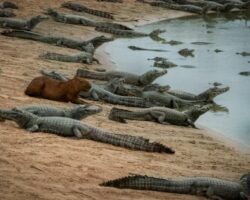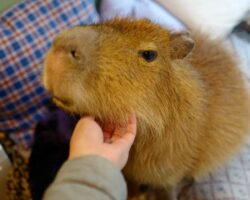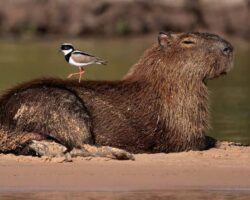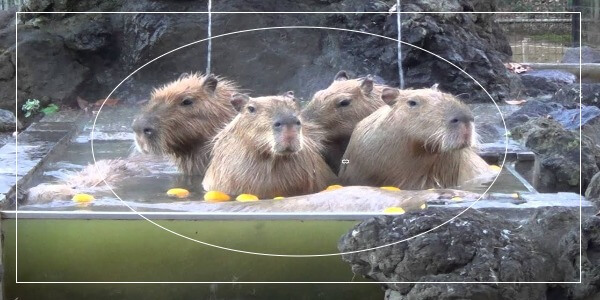Capybaras are cute, friendly, and adorable animals. While they are peaceful creatures, they can be a tasty meal for several predators in the wild.
Capybaras live in South America, they are semi-aquatic animals and typically spend a lot of time in water. They are the largest rodent species in the world and can grow as big and heavy as a Labrador dog.
Back to the question – what eats a capybara? The capybara is prey to animals such as anacondas, caimans, jaguars, pumas, ocelots, and even humans. Capybaras live in the thick forests of South America, which is surrounded by most of their predators.
The estimated lifespan of a capybara is between eight to ten years. However, most capybaras have their lives cut short at four or five, as they are hunted or eaten by predators.
Baby capybaras are easy targets for predators, as they are highly inexperienced and possess poor judgment of who their friends and enemies are. Harpy eagles and other large birds go after baby capybaras as they are easy to capture and lift.
Most times, capybaras evade predators by submerging themselves underwater until the predators are out of sight. These rodents have webbed feet that help them swim quickly in water. In this article, we will reveal more facts and details about the capybara predators, and how they hunt down capybaras.
What Eats Capybaras?
Capybaras are aware of the dangers in the world. They stay together in groups of ten to twenty members. The group typically grows during the dry season and may have up to 40 or more capybara. A capybara can alert other capybaras of danger or threats by making barking sounds and noises.
Capybaras are juicy meals for many animals in the wild due to their large size and meat. They are hunted by several deadly carnivorous animals in water and on land. The following predators below prey on capybaras:
1. Caimans

Caimans are one of the most common capybara predators. They are large reptiles, that can reach expansive lengths of over 20 feet.
Caimans are closely related to crocodiles and alligators but are quite large in size. They possess extra-sharp razor-like teeth that cut deep and tear away the flesh of their prey.
Caimans can be found in South America’s rainforests, where the capybara also stays. They stay in freshwater environments and share the same natural habitat as the capybara and are found in swamps, lakes, ponds, rivers, and other water bodies.
They typically hunt capybaras, rodents, and other unsuspecting animals who visit the water to have a drink.
Caimans hunt by using their sharp teeth to have a grip on their prey. Then they drag the prey into the water, where they take it underwater, where it will drown. Since the capybara has remarkable breath-holding skills, capturing the rodent is different.
When they see a capybara, they stalk the animal until they are sure of catching it when they make their attack. They grab the rodent with their sharp teeth and cut it to pieces.
Caimans are night hunters, they tend to hunt their prey when it is less active. These large reptiles eat small animals, rodents, rabbits, birds, fishes, and other reptiles.
2. Jaguars

The jaguar is one of the most powerful hunters in the wild. They are incredibly skillful when it comes to hunting. They are good climbers, runners, and swimmers.
Jaguars are large cats with sharp claws and powerful jaws. They can hunt their meals at any time but their powerful night vision gives them the upper hand in hunting their unsuspecting prey like capybaras at night.
Jaguars is the third largest cat in the world, making it one of the most threatening in the wild. They eat a variety of animals, including fishes, tapir, caimans, armadillos, and capybaras.
They can be found in the South American rainforests hunting capybaras and other animals. Their spotted fur makes them adapt and camouflage with the surroundings, giving them a good chance of killing their prey.
Jaguars can hunt in darkness thanks to their powerful night vision and their spotted fur, which gives them the advantage of moving unnoticed. They hunt capybaras in the early mornings or when the animal is retiring for the night.

While capybaras are good swimmers, they may not be able to evade jaguars, who are strong swimmers and can catch them in water. Once a capybara is caught by the cat, it takes it to a dry land, where it will devour it.
3. Green Anacondas
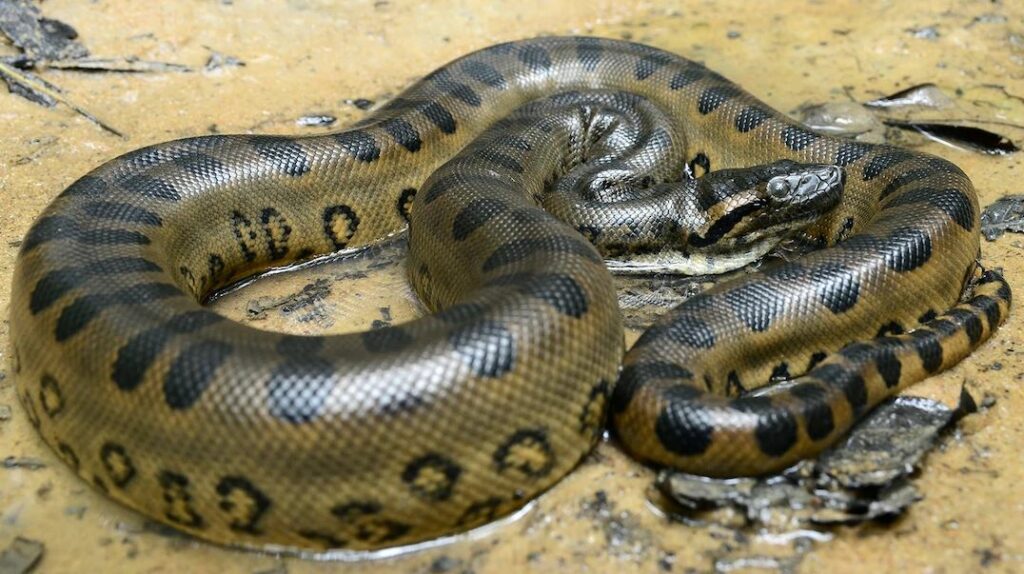
Green anacondas are large snake species found in tropical rainforests. Anacondas are incredibly large and big, with some of them growing as large as 30 feet long.
Like the capybaras, these reptiles come from South America and live near swamps, marshes, rivers, and other water bodies. Green anacondas can eat any animal but their preferred diet consists of animals like capybaras, fishes, turtles, deer, birds, rodents, reptiles, mammals, and reptiles.
Anacondas hunt their prey at night when the animal is less active. They hunt in water and target a lot of aquatic animals.
Their hunting strategy is different from other predators. When the anaconda finds prey, it runs after the animal, grabs it with its powerful jaws, and coils around it. At this point, the animal has little or no chance of escape.
The tight squeeze can suffocate or weaken the animal. The anaconda can also launch a fatal bite on its prey to kill or weaken it. After killing their prey, they swallow it entirely.
4. Ocelots

Ocelots may be smaller cats but are one of the most threatening predators in the wild. These beasts are all-complete hunters as they are excellent runners, climbers, and swimmers. Ocelots can take down their prey at any location, whether on land or near water bodies.
These cats aren’t scared of going into the water to attack their prey. They typically go after capybaras when they are in the water resting.
Ocelots commonly hunt around shallow waters, especially ponds, lakes, rivers, and streams, where they can prey on animals like the capybara. The humongous size of capybaras makes it a perfect, satisfying meal for the ocelot.
Ocelots are smart hunters. They can spend several hours tracking their prey until they are close enough to kill it. These cats tend to stalk their prey for a long time until the perfect opportunity comes.
Once the ocelot goes closer to its prey, they pounce on it and kill it using their powerful claws and sharp teeth. They kill their prey quickly by biting its throat. Once this is achieved, the prey is at the mercy of the ocelot. Once the prey dies, the ocelot takes it to a safe place, like a tree, where it can eat without any interruption or distraction from other predators in the wild.
5. Puma

Pumas are powerful, big cats that hunt capybaras and other animals in the wild. The puma has several names and has been called a mountain lion, cougar, catamount, Florida panther, and many more.
The puma has a short, brownish-red coat, and they are very large. On average, pumas weigh between 100 to 200 pounds.
These large cats are predominant in North and South America. They typically eat deer, fishes, birds, and rabbits, but may eat capybaras in the absence of their favorite meal.
Pumas are clever hunters, they have a great vision for prey. Like other large cats, pumas stalk their prey stealthily until they are certain of catching them when they attack. They have great night vision, which they use to creep up on their prey at night.
While capybaras are resting in the night, these wild cats can ambush them and take down any of the members. Pumas have powerful, muscular legs, they run with excellent speed and can climb up to 15 feet high, making them powerful hunters of the wild.
They take down their prey by pouncing on the animal with their powerful hind legs, delivering a strong blow before launching a deadly bite in the neck or throat region, leaving the animal with lethal wounds.
Pumas are carnivores and can consume a lot of animals in the wild, including rodents, rabbits, fishes, birds, and deer. Once it can’t find deer in the forest, it begins looking for alternative meals like the capybara.
The size of the capybara is a big kill for the puma. If it can’t eat all the parts of its prey, it uses its strong jaws to drag the carcass to its hideout or any safe area, where it can find it to eat again at a later time.
6. Crab-Eating Fox
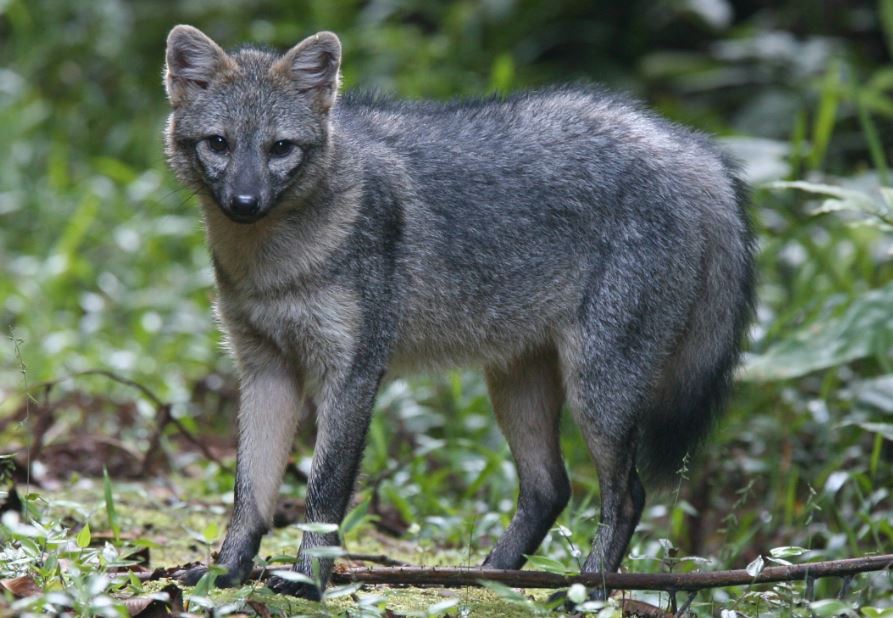
Crab-eating foxes are found in South American forests, including Argentina, Brazil, and Uruguay. They eat a lot of small animals in the wild, including crabs, crayfish, and rodents.
These predators hunt small animals and would not attempt to attack a fully-grown capybara. Rather, it goes after the younger, and most vulnerable ones.
Crab-eating foxes delight in eating their favorite meal, which are crabs, crayfish, and other small aquatic animals. Its favorite meal is readily available during the wet season, but in the dry season, it can turn attention to other animals like young capybaras for food.
Crab-eating foxes also eat plant species and other small invertebrates. They aren’t too powerful as jaguars, they hunt in groups and sometimes hunt alone.
They take down their prey with their sharp claws and teeth, and then they take the meal to a safe place where it can be eaten in peace.
7. Harpy Eagles
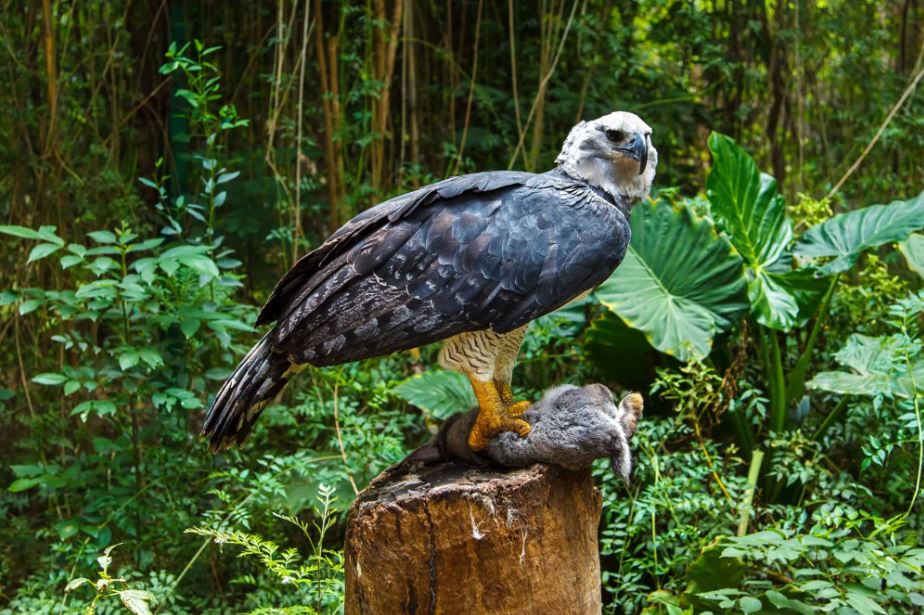
Capybaras are one of the most vulnerable animals because they face a lot of threats in the wild. These large rodents have a duty to keep watch over themselves as they can be attacked in water, on land, and on trees.
The large size of both young and adult capybaras can fill the belly of any predator, regardless of its appetite and hunger. One of the biggest and most powerful birds is the harpy eagle.
Harpy eagles are powerful hunters, they stay at the treetop observing the area, waiting to find prey. Aside from their large size, they have great vision and an expansive wing that reaches over six feet.
Harpy eagles are strong enough to lift animals that are over four times their own weight. They can lift big animals like sloths and monkeys off the ground and take them to their nest to be eaten.
Harpy eagles can be found in South American forests, they share the same habitat as the capybara. These big birds typically perch on tall trees near swamps, ponds, rivers, and other water bodies, waiting for their next meal.

When their prey comes in sight, they attack by diving down at high speeds and then snatching the animal with their sharp talons. The prey is less likely to survive when caught by the harpy eagle as it grips its prey tightly, and sometimes, the animal may die before it gets to the home of the bird.
Harpy eagles eat capybaras. After capturing an animal, they take it to their nest, where it will be consumed by their family.
8. Human Beings

Believe it or not, human beings are one of the biggest threats to Capybara’s existence. Humans are capybara predators. For many years, these predators have hunted the capybara in South American forests for their meat and hides.
Capybaras are docile and do not attack humans or threaten them in any way unlike other wild animals, humans hunt them for their sweet, tender meat. Some hunters say capybara meat tastes like pork and others say it has a fish-like taste.
Capybara meat is cooked and eaten in several South American regions. For instance, their meat is served at weddings, get-togethers, and other special festivals and events in Venezuela.
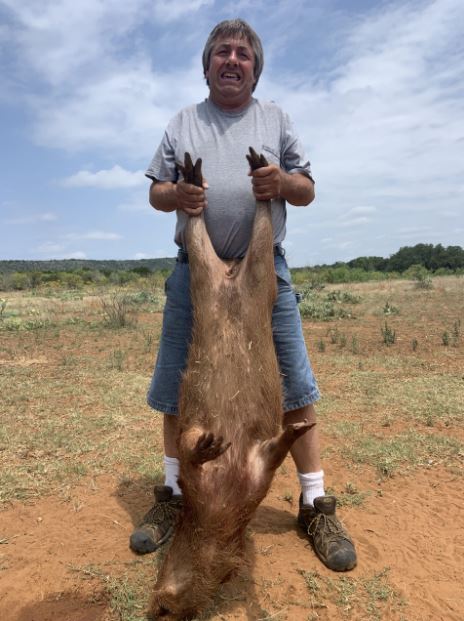
The capybara isn’t just a source of food to humans, they also provide hide and pelts, which are often used in producing clothing and leather for bags, shoes, belts, hats, and other items.
Many companies and businessmen pay hunters to fetch them capybara hides and meat, which they use in the manufacturing of consumer goods.
Despite these threats, the capybara population is stable. However, there are concerns about the existence of the rodent in the long run. There are areas in South America that used to have capybaras but are currently facing a shortage of disappearance of rodents due to overhunting.
Like goats and poultry, some farmers breed capybaras for their meat, either for personal consumption or commercial intent. Overall, human beings are the biggest predators and threats to capybara existence.
Humans have a big role in preserving life and ensuring the longevity of capybaras on Earth. Capybaras can survive and defend themselves in the wild. These rodents have existed for thousands of years and have faced threats from different predators in their habitat.
However, their chances of survival in human communities are slim, as people hunt them for different purposes. Likewise, some capybaras die in captivity due to poor care and irresponsibility on the part of their owners.
How Do Capybaras Defend Themselves In The Wild?
As extra-large rodents, capybaras are big meals for any carnivorous animal. They come from South American forests, which have some of the most deadly predators on the planet.
Capybaras are semi-aquatic animals, and they can be eaten by terrestrial or aquatic animals that share the same habitat as them. Green anacondas and caimans eat capybaras in the wild.
The estimated lifespan of a capybara is between 8 to 10 years but most capybaras don’t live long because of attacks from predators as well as hunting by humans.
Most baby capybaras do not live long or make it to adulthood because they are the easiest targets for most predators. Baby capybaras, also known as pups, and the most vulnerable, and are easily captured by harpy eagles, ocelots, jaguars, and other predators.

Capybaras stay in groups of 10 to 30 capybaras. These animals are highly sensitive. Once they sense danger or threat around them, they issue barking shouts to alert the rest of the herd. The group evades the threat by running into any water body nearby and hiding there until the threat is gone from sight.
Frequently Asked Questions
Are Capybaras Predators?
Capybaras are herbivores, they do not harm or kill other animals for food. They rely on grasses, fruits, water plants, and vegetation for food. However, sometimes, they can eat small turtles.
Do Capybaras Get Eaten?
The capybaras is a tasty meal for several people, including humans and animals. Several predators, including caimans, jaguars, eagles, and ocelots consume the rodent.
Likewise, capybara meat is a delicious meal eaten in many countries. Their meat is a popular delicacy in Latin and South America, especially in Venezuela, where it is eaten during Lent.
Do Crocodiles and Alligators Eat Capybaras?
Surprisingly, crocodiles and capybara are buddies. They do not attack the rodents but seem to get along with them whenever they meet each other.
There are several reasons why the crocodile don’t eat capybaras. However, large reptiles like caimans will devour capybaras without taking a second thought.
How Do Cappybara Evade Predators?
Capybaras typically survive in the wild by staying together with their kind in the wild. Capybaras stay in groups with other capybaras and they may bark and make different noises when they sense danger.
When threatened by predators, capybara scamper to any safe place they can find. They typically hide underwater to evade predators. These giant rodents are capable of staying underwater for five minutes while holding their breath.
Conclusion
The capybara is a large animal, which makes it a juicy, tasty meal for any hungry predator in the wild. This article shows some of the most deadly and powerful predators that eat the capybara. You can also add yours to the list.

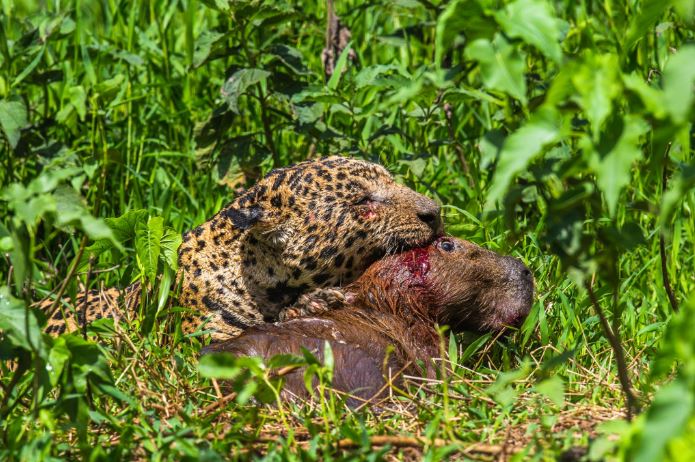

![Capybara Meat And Its Culinary Uses - [Every You Should Know] Capybara Meat & Culinary Uses](https://capybaratips.com/wp-content/uploads/2023/03/Capybara-meat-250x200.webp)
